SOUND for Class 9 PHYSICS
INTRODUCTION
Hum har din different sources se different sounds sunte hain. Eg: Alarm ka sound, church bell, school bell, car ya bus ke horn, different instruments se music etc. Hum sound ko humare taraf aate dekh nahi sakte pr sound hamare ears tak reach krta hai, waves ke form me jo medium ke particles ke vibrations ke karan form hote hain. Waves apne saath vibrating particles ka mechanical energy carry krte hain taki humare ears me hearing ka sensation produce ho.
THEME

The theme of the poem 'Sound' revolves around the degradation that nature has suffered in the past few years. This poet mainly criticises modern men who are blunt and insensitive to the agonies of the trees. The 'Sound' is nature's love that lays before the men who want the destruction of the environment to satisfy their greed.
EXPLANATION
"साउंड" का विषय उस क्षय के इर्द-गिर्द घूमता है, जो पिछले कुछ वर्षों में प्रकृति ने झेला है। कवयित्री मुख्य रूप से आधुनिक लोगों की आलोचना करती है जो पेड़ों की पीड़ा के लिए कुंद (blunt) और असंवेदनशील हैं। "साउंड" कविता उन लोगों के बारे में है जो अपने लालच को पूरा करने के लिए पर्यावरण को नष्ट करना चाहते हैं।
PRODUCTION OF SOUND
EXPERIMENT 1:
1. Ek thin wire lenge aur use do nails ke beech stretch krenge.2. Ek paper ka chhota tukra (rider) wire ke beech place krenge aur phir wire ko pluck krenge.
3. Hum notice krenge ki rider ur jata hai jab wire vibrate hone lagta hai aur sound produce hota hai.
4. Thore der baad jab wire vibrate hona band kr deta hai toh koi sound sunai nahi deta hai.
Hence, sound is produced due to vibrations.

EXPERIMENT 2:
1. Ek plate aur spoon lenge.2. Spoon ko plate par strike krenge toh sound produce hoga.
3. Jab hum plate ko touch krenge toh hum notice krenge ki plate vibrate ho raha hai.
4. Ek ball ko thread se tie krke plate ke paas le jaenge.
5. Hum notice karenge ki ball vibrations ke karan move kr raha hai.
Hence, sound is produced due to vibrations.
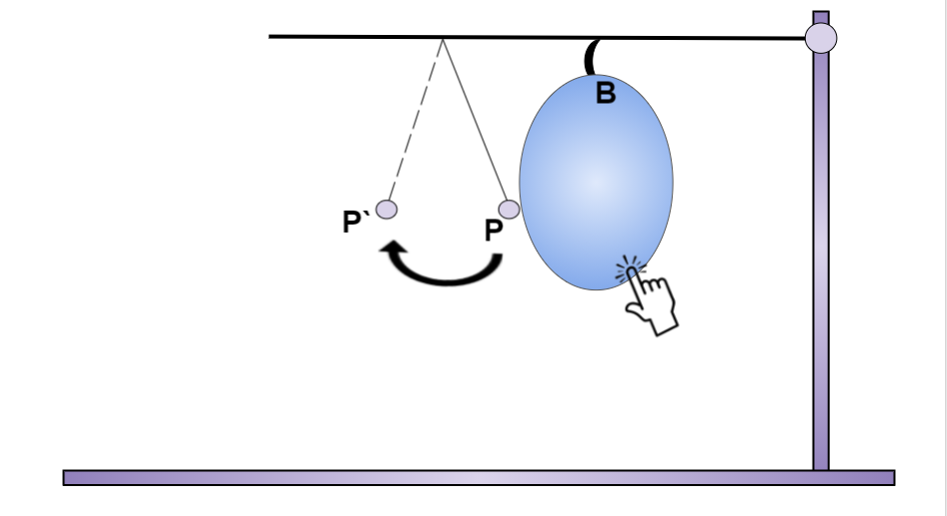
PROPAGATION OF SOUND
Sound is a form of energy that produces the sensation of hearing in our ears. Sound is produced by vibrating objects. The matter or substance through which sound is transmitted is called a medium. It can be solid, liquid or gas.Niche diye gaye image me aap dekhenge ek loudspeaker hai aur thore distance pr listener hai. Jab loudspeaker on hoga toh sound produce krega. Kya aap jante hain ki sound listener tak kaise jaegi? Air particles ke through sound travel karta hai.Loudspeaker aur listener ke beech air medium hai. Jab loudspeaker se sound produce hoga toh vaha se sound energy niklegi aur air particles ek dushre se takraenge phir apne place par wapas aa jate hain. Yaha par Kinetic energy ek particle se dusre particle ko transfer hoti hai. Ye repeat hota jata hai aur particles ka to and fro motion (vibration) hota hai. Air particles energy transfer krte hai.

Air particles evenly distributed nahi hote hain. Kahin jyada hote hain, kahin km hote hai. Jab sound propagate krti hai toh 2 regions bante hain;
1. Region of rarefaction: Ye region km dense hota hai mtlb km mass hota hai kyunki km air particles hote hain. Yaha particles ek dusre se dur hote hain.
2. Region of compression: Ye region jyada dense hota hai mtlb jyada mass hota hai kyunki jyada air particles hote hain. Yaha particles compressed hote hain.
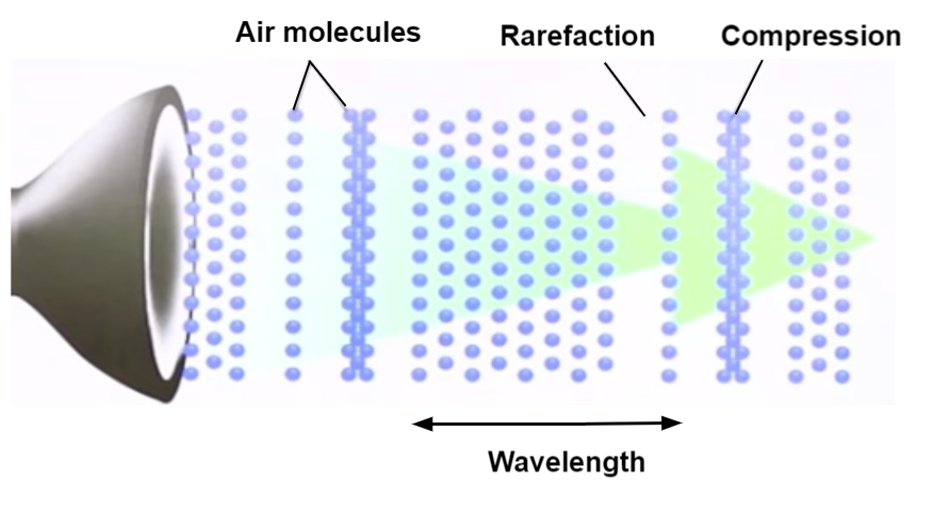
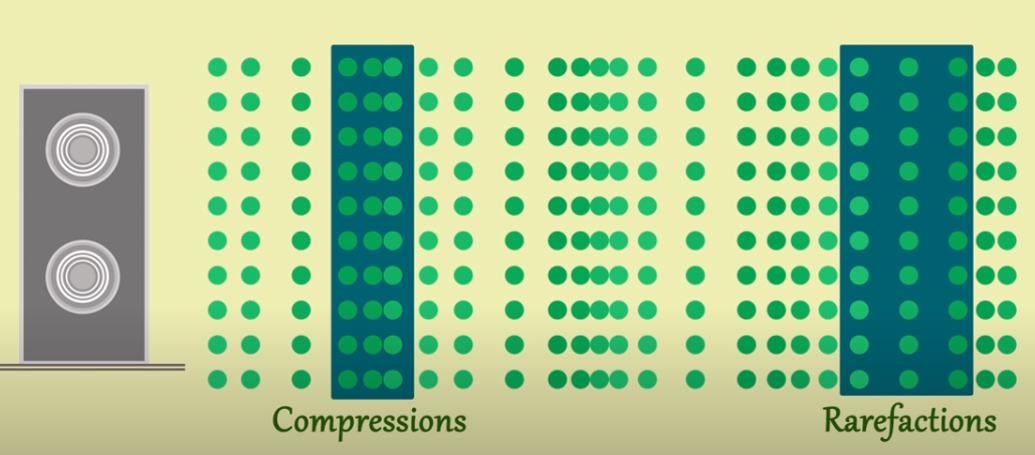

Jab body vibrate krta hai tab sound produce hota hai. Jab object vibrate krna band kr deta hai tab sound produce hona bhi band ho jata hai. Sound ek medium ke through point of generation se listener tak move krta hai.
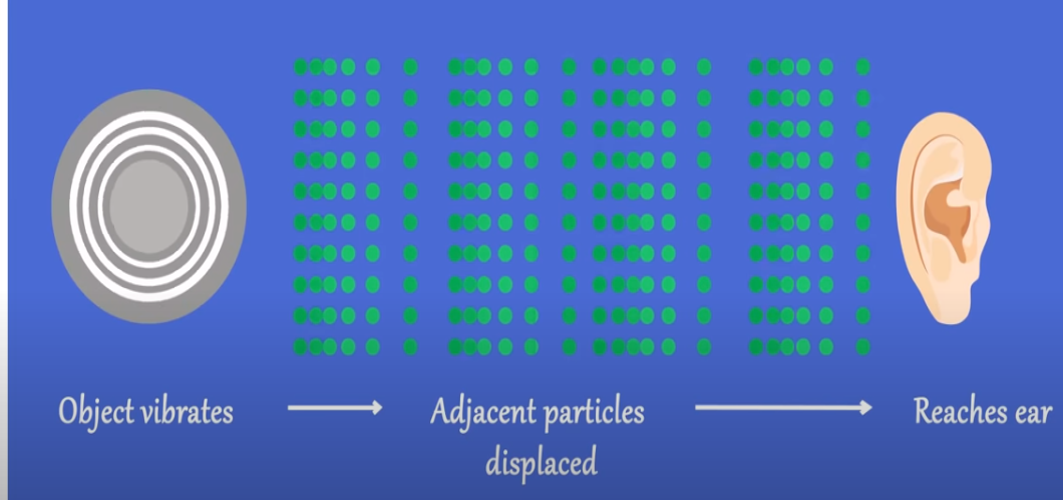
OMR (One Minute Revision)
- * Sound is produced by vibrations.
* Sound is produced when a body vibrates and it reaches us through the vibrations of the particles of the surrounding medium (air, solid aur liquid). Thus, sound requires a medium of its propagation.
SOUND NEEDS A MEDIUM TO TRAVEL
Vibrating body se sound produce hote hain aur vo ek place se dusre place travel krte hain waves ke form me jo medium ke particles ke vibrations ke karan form hote hain. Jab ye vibrations hamare ears tk reach hote hain, tb hume sound sunai deta hai. Iska mtlb sound ke propagation ke liye ek material medium hona jaruri hai.BELL JAR EXPERIMENT
1. Ek electrical bell lenge aur air tight bell jar lenge.
2. Bell ko airtight bell jar me suspend kr denge.
3. Jab bell ka switch press krenge toh bell ka hammer gong pr baar baar strike krta hai aur sound produce hota hai.
4. Switch ko pressed rakhkr hi phir bell jar ko vacuum pump se connect krenge aur bell jar se sara air pump kr lenge.
5. Hmlog observe krenge ki bell ka sound km hote ja ra jabki same current electric bell ko pass ho raha hai.
6. Jitna km air hoga bell jar ke ander utna hi km bell ka sound aaega.
7. Jab air completely remove ho jaega tab koi sound sunai nahi dega.
8. Hum dekhte hain ki electric bell ka hammer baar baar gong pr strike kr raha hai, iska mtlb gong vibrate ho raha hai sound produce krne ke liye pr koi sound sunai nahi deta hai.
9. Is experiment se hum ye samjhte hai ki sound vacuum me travel nahi kr sakta hai.
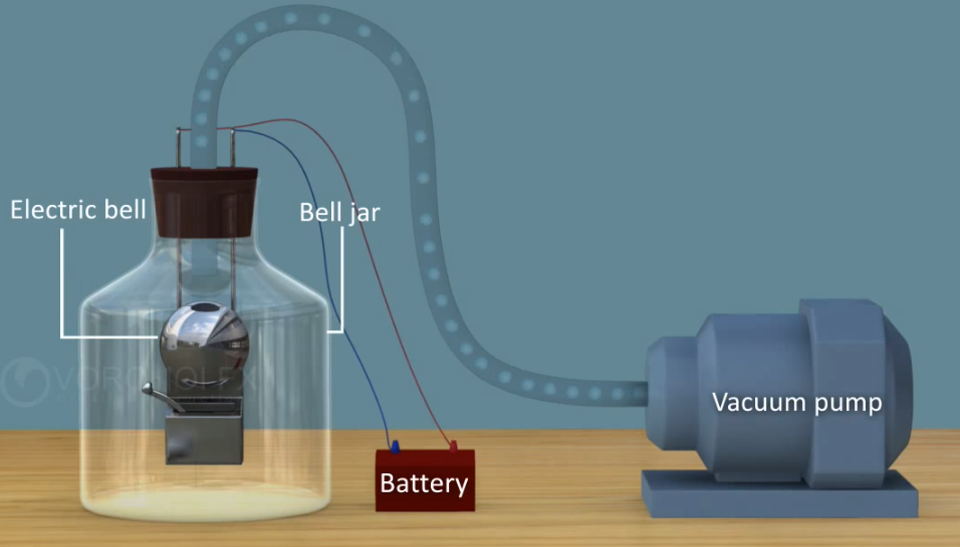

Jab amount of air decrease krti hai, tab intensity of sound bhi decrease krti hai.
Sound requires a material medium for its transmission and it cannot travel through vacuum.
Requisites of the Medium
Sound ke propagation ke liye jo medium lagta hai uske 3 properties hone chahiye:
1. Medium elastic hona chahiye taki wo displacement ke baad apne original position pr return ho sake.
2. Medium ke paas inertia hona chahiye taki uske particles mechanical energy store kr pae.
3. Medium frictionless hona chahiye taki sound ke propagation me koi energy loss nahi ho.
OMR (One Minute Revision)
- * A material medium is necessary for the propagation of sound from one place to another.
* Sound cannot travel in vacuum.
SOUND WAVES ARE LONGITUDINAL WAVES
Jis wave me medium ke particles apne mean position pr vibrate krte hain, propagation of sound ke direction me usse longitudinal wave kehte hain. Yaha particles ek place se dusre place move nahi krte hain, wo apne mean position pr oscillate krte hain. Aise hi sound waves bhi propagate krte hain isliye sound waves longitudinal waves hote hain.Longitudinal wave : When the particles of the medium vibrate along the direction of propagation of the wave then the wave is known as the longitudinal wave. For example sound waves in the air.
Transverse wave dusre type ka wave hai. Isme particles apne mean position par vibrate karte hain, wave propagation ke perpendicular direction me.
Transverse wave : When the particles of the medium vibrate in a direction perpendicular to the direction of propagation of the wave, the wave is known as the transverse wave. For example, waves produced in a stretched string.
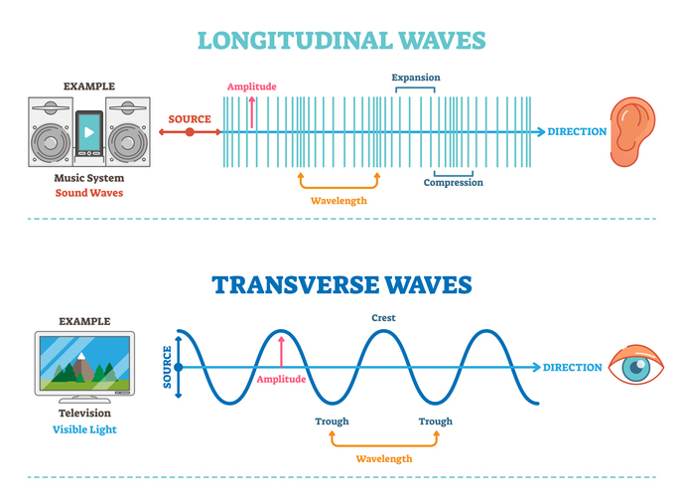
CHARACTERISTICS OF A SOUND WAVE
Alag prakar ke sound ko kya alag krta hai. Ye frequency aur amplitude hote hain. Jo bhi sound hum sunte hain usme kuch amplitude aur frequency hote hain. Ager hum inme se kisi bhi ek ko badalte hain, toh hume ek alag sound sunai deta hai. Amplitude sound ke loudness ko determine krta hai aur frequency sound ke pitch ko determine krta hai.More frequency, high pitch. Less frequency, low pitch.
Sound wave can be determined by its frequency, amplitude and speed.
Amplitude maximum displacement hai jo medium ka particle apni equilibrium position se cover krta hai.
Sound waves jyada pressure wale region jinhe compression kehte hain aur km pressure wale region jinhe rarefaction kehte hain, unki ek continuous cycle hoti hai. Ye sound wave ek puri cycle tab complete krti hai jab medium ka density maximum value se minimum value tak move krti hai aur phir se maximum pr jati hai. Tab hum kehte hain ki sound wave ne ek oscillation pura kr liya hai. Ye sound wave ki ek oscillation hai, maximum se maximum tak. Oscillation ke representation me ek compression aur ek rarefaction hota hai.
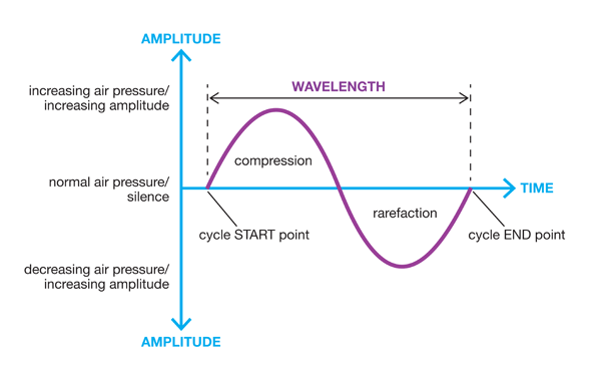

Ek unit time me oscillations ke number ko sound wave ki frequency kehte hain.
Do lagatar compression ya do lagatar rarefaction ke peak value ki duri ko wavelength kehte hain.
Do lagatar compressions ya rarefactions dwara kisi bhi point ko paar krne ke liye, liye gaye time ko hum time period kehte hain. Ye wo time hai jisme ek wave apni wavelength ke barabar duri pura karti hai. Ager aapko yaad ho toh wavelength ek oscillation ki length hai, toh time period vo time hai jisme sound wave ek oscillation pura krti hai.
SPEED OF SOUND IN DIFFERENT MEDIA
Sound ka speed ek particular medium ka uske temperature aur pressure pr depend krta hai. Solid ka density, air aur liquid ke density se jyada hota hai, isliye sound ka speed solid me maximum hota hai.Speed of sound is different in different media. Speed of sound is more in solids, less in liquids and least in gases since solids are much more elastic than liquids and gases.
SPEED OF SOUND IN DIFFERENT MEDIA AT 25 DEGREE CELSIUS

POINT 1
Frequency :
The number of vibrations per second is called frequency. The unit of frequency is hertz (Hz).
Amplitude:
The maximum displacement of each particle from its mean position is called amplitude. The S.I. unit of amplitude is metre (m).
Time period:
The time taken to complete one vibration is called time period. It is denoted by T and S.I unit of time period is second(s).
Frequency= 1/(Time period) or v=1T
Wavelength:
The distance between two nearest (adjacent) crests or troughs of a wave is called its wavelength. The wavelength is usually represented by λ (Greek letter lambda). S.I unit of wavelength is metre (m).
Velocity of wave:
The distance travelled by a wave in one second is called velocity of the wave (or speed of the wave). The S.I. unit for the velocity of a wave is metres per second (m/s or ms-1).
Pitch :
Pitch is the sensation (brain interpretation) of the frequency of an emitted sound and is the characteristic which distinguishes a shrill (or sharp) sound from a grave (or flat) sound.
Loudness :
It is a measure of the sound energy reaching the ear per second.
ABOUT THE AUTHOR

RAJANI PARULEKAR (b. 1945), recipient of Maharashtra State Award, is a poet in Marathi with three collections of poems to her credit. The present poem, taken from Indian Literature, has been translated by Suhas Sooryakant Limaye.
EXAMPLE 1
A sound wave has a frequency of 2 kHz and wave length 35 cm. How long will it take to travel 1.5 km?
Given,
Frequency, ν = 2 kHz = 2000 Hz
Wavelength, λ=35cm=0.35m
We know that speed, v of the wave = wavelength × frequency
ν=λν
=0.35m×2000Hz=700m/s.
The time taken by the wave to travel a distance, d of 1.5 km is
t=dv=1.5×1000m700ms−1=157s=2.1s
Thus sound will take 2.1 s to travel a distance of 1.5 km.
EXPLANATION
महाराष्ट्र राज्य पुरस्कार से सम्मानित, रजनी पारुलेकर (b. 1945), एक मराठी कवयित्री हैं, जिनके पास तीन कविताओं का संग्रह हैं। भारतीय साहित्य से ली गई इस कविता का अनुवाद सुहास सूर्यकांत लिमाये ने किया है।
EXAMPLE 2
The wavelength of sound emitted by a source is 1.7×10−2m. Calculate frequency of the sound, if its velocity is 343.4ms−1.
The relationship between velocity, frequency and wavelength of a wave is given by the formula:
v=f×λ
Here, Velocity, v=343.4ms−1
Frequency, f=? (To be calculated)
And, Wavelength, λ=1.7×10−2m
So, putting these values in the above formula, we get:
343.4=f×1.7×10−2
f=343.41.7×10−2
f=3434×10217
f=2.02×104Hz
Thus, the frequency of sound is 2.02×104 hertz.
PARAGRAPH 1

A tree in the woods is hacked
It’s branch breaking away
what do the halves
whisper to each other?
Do they moan and groan
In the heart of their hearts?
And do these logs driven from each other Reminisce?
EXAMPLE 3
Sound waves travel with a speed of about 330m/s. what is the wavelength of sound whose frequency is 550 hertz?
Here, Speed of waves, v=330m/s
Frequency of waves, f=550Hz
And, Wavelength, λ=? (To be calculated)
Now, v=f×λ
So, 330=550×λ
λ=330550
λ=0.6m
Thus, the wavelength of sound waves is 0.6 metre.
IMPORTANT WORDS
Woods:- Forests, जंगल
Hacked- cut or chopped roughly, काट देना
Halves- plural of the half, आधा का बहुवचन
Log- thick piece of wood that has fallen or been cut from a tree, लकड़ी का कुंदा जो पेड़ से गिर कर अलग हुआ है या काटा गया है
Reminisce- to talk about pleasant things that happened in the past, अतीत की सुखद बातों की चर्चा करना
EXAMPLE 4
If a thunder is heared by a man 4 seconds after the lightning is seen, how far is the lighting from the man? (Speed of sound in air =330m/s).
We know that light travels at a great speed as compared to that of sound, therefore, the flash of light of 'lightning' will reach the man in no time but sound takes 4 seconds to reach the man. Now:
Speed of sound =330m/s
Distance = ? (To be calculated)
And Time =4s
We know that: Speed =DistanceTime
So, 330=Distance4
And, Distance =330×4m=1320m
Thus, the lightning is at a distance of 1320 metres from the man.
EXPLANATION
कवयित्री बड़े ही दुख के साथ कहती है कि जंगल में जब एक पेड़ को काट दिया जाता है तो इसकी शाखाऐं टूटकर अलग हो जाती है। कवयित्री सोचती है कि पेड़ के आधे कटे भाग एक दूसरे से धीरे-धीरे क्या बातें करते हैं? क्या वे अपने दिलो में एक दूसरे के लिए दुख ज़ाहिर करते है ? क्या वे शोक मनाते हुए एक दूसरों के दिलों में होने वाली पीड़ा से कराहते और चिल्लाते हैं? और क्या वे दो लकड़ी के टुकड़े जो अब पेड़ से अलग हो गए है, एक दूसरे से बीते हुए दिनों के बारे में याद करते होंगे ?
EXAMPLE 5
Establish the relationship between speed of sound, its wavelength and frequency. If velocity of sound in air is 340ms−1 . Calculate
(i) wavelength when frequency is 256 Hz.
(ii) frequency when wavelength is 0.85 m.
The speed of sound is defined as the distance which a point on a wave, such as a compression or a rarefaction, travels per unit time.
We know that, speed (v) =distancetime=λT
Here, λ is the wavelength of the sound wave. It is the distance travelled by the sound wave in one time period (T) of the wave
v=λT=λ×1T
We know that, v=1T (Where v=frequency)
i.e., Speed=wavelength × frequency
Given, speed of sound in air v=340 m/s and frequency v=256 Hz.
(i) ∴ Speed = wavelength × frequency
⇒340=λ×256
⇒λ=3402561.33m
(ii) Again, given
wavelength λ=0.85m
Then, frequency of sound in air , v=speedwavelength (∵ speed=wavelength × frequency)
⇒ v=3400.85=340×10085=400Hz
Thus, frequency of sound is 400 Hz.
PARAGRAPH 2
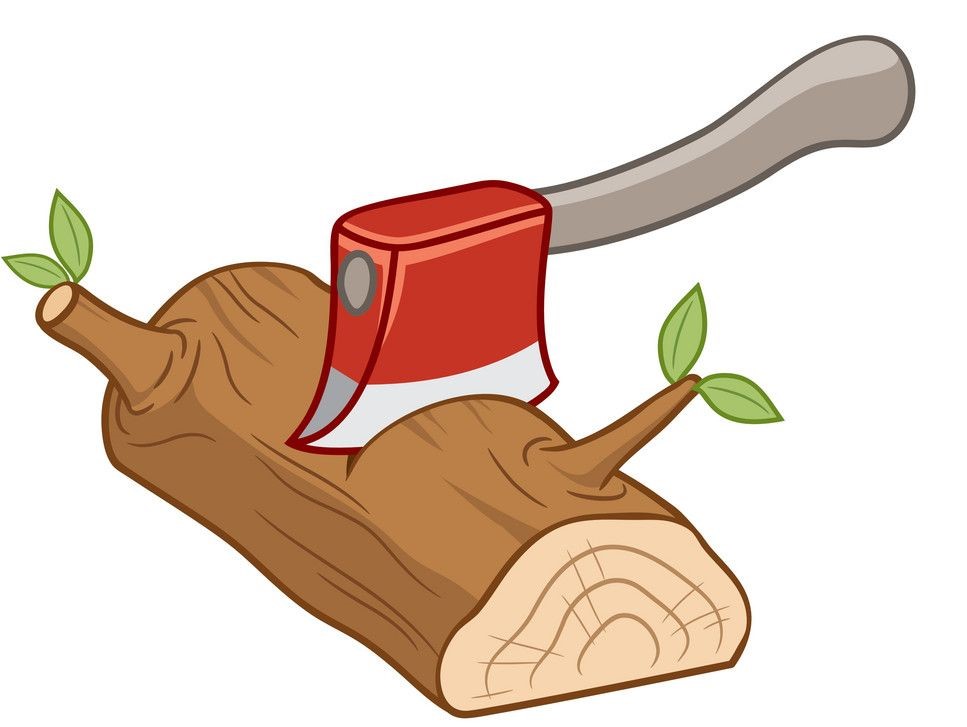
Do they remember how the wind tossed them?
How they got drenched in the rain?
And the blossoms in the spring
And the fall in autumn?
Oh! But the wind knows,
The wind blowing with a din
In places forlorn
Sings such songs
Those songs not all could praise
EXAMPLE 6
An echo is returned in 3s. What is the distance of the reflecting surface from the source, given that the speed of sound is 342m/s.
Speed of sound, v=342ms−1
Echo returns in time, t = 3 s
Distance travelled by sound =v×t=342×3=1026m
In the given time interval, sound has to travel a distance that is twice the distance of the reflecting surface and the source.
Hence, the distance of the reflecting surface from the source= 1026 / 2 m = 513 m.
IMPORTANT WORDS
Toss- to swing in the wind, हवा में झूलना या लहराना
Din- a lot of unpleasant noise that continues for some time, शोर-शराबा, हल्ला-गुल्ला
Forlorn- lonely and unhappy; not cared for, अकेला और उदास; उपेक्षित
REFLECTION OF SOUND
Light waves ke jaise hi sound waves bhi surface se reflect hote hain. Sound waves bhi same law of reflection ko follow krte hain.
When sound waves strike a surface, they return back into the same medium. This phenomenon is called reflection of sound.
Ager hum ek source of sound lete hain aur assume krte hain ki ek sound wave surface ko ek point pr strike krta hain aur us surface ke point se normal lete hain, (line which is perpendicular to the surface at the point of incidence) toh ye wave surface se reflect ho jata hai. Law of reflection hume ye batata hai ki sound wave reflect back ho jata hai aur angle of incidence(i) angle of reflection (r) ke dono equal hota hai. Incident ray, reflected ray aur normal sabhi same plane me lie hote hain.

Laws of reflection :
1. Angle of incidence is equal to the angle of reflection.
2. The incident wave, the reflected wave and the normal all lie in the same plane.
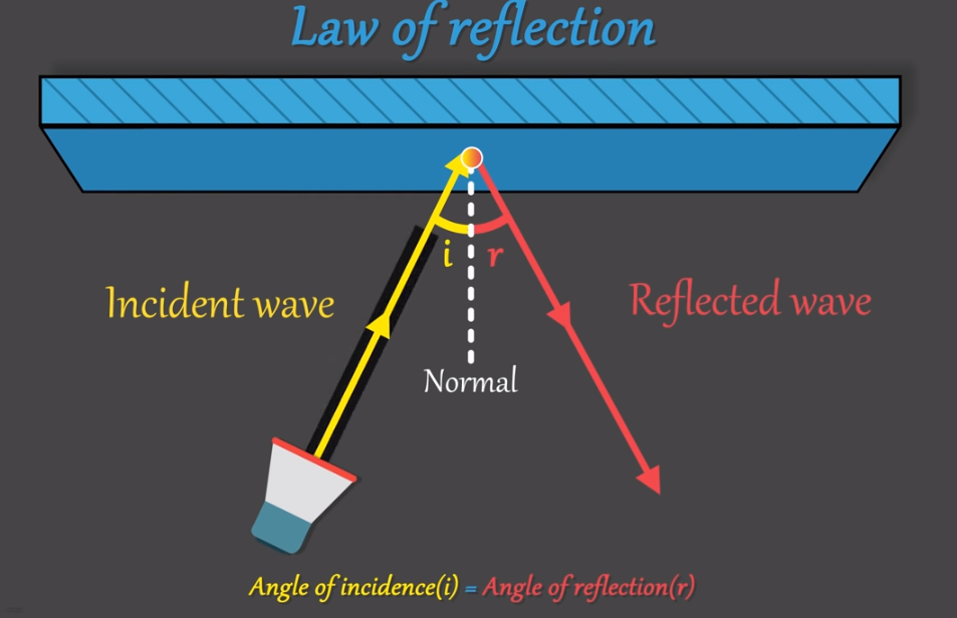
Jab ek wave incident surface se perpendicular hota hai tab reflected sound same line me travel back krega opposite direction me.
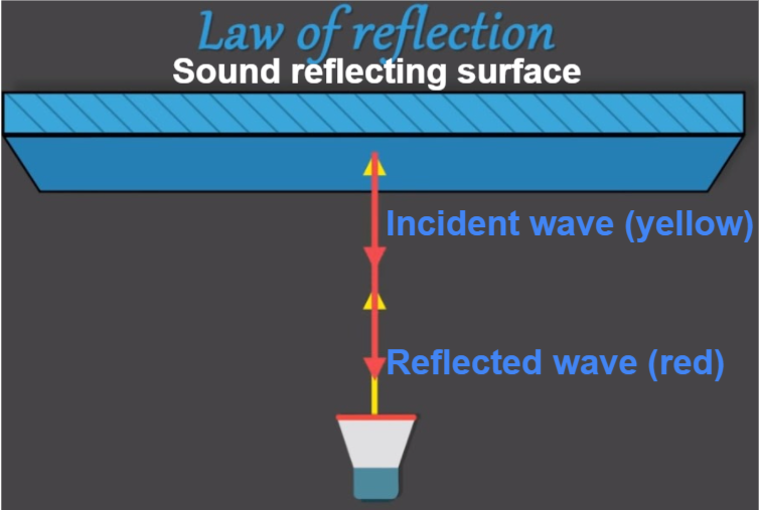
ECHO
Baar baar same sound ke repetition ko echo kehte hain. Echo usually empty spaces me sunai deta hai.Phenomenon of hearing back our own sound is called an echo. It is due to successive reflection from the surface obstacles of large size.
Ager hum ek empty space me bare se wall ke against clap krenge toh hum clap ka sound baar baar sunenge. Hamare clap ka sound ka har possible direction me travel krta hai. Jab ye obstacle se collide krta hai toh ye reflect back ho jate hain. Reflected sound waves hamari taraf travel krte hain aur hum baar baar clap ka sound sunte hain.
Echo temperature aur hamare aur point of reflection ke beech ka distance pr depend krta hai.
Conditions for the formation of Echoes:
(i) Source of sound aur reflecting body ke beech ka minimum distance 17.2 metres hona chahiye.
(ii) Sound ka wavelength reflecting body ke height se km hona chahiye.
(iii) Sound ka intensity sufficient hona chahiye taki reflection ke baad sunai de sake.

Room me koi bhi object nahi hone ke karan jyadatar sound jo hum krte hain wo diwaron tak pahunchkar inke surfaces se reflect ho jati hai ager diwaren koi bhi sound absorbent material se covered nahi ho toh. Diwaren kuchh sound absorb krti hain lekin jyadatar sound room me wapas reflect ho jati hain.
Sound ka sensation hamare brain me 0.1 s tak bana rehta hai. Distinct echo sunne ke liye original sound aur reflected sound ke beech ka time interval at least 0.1 s hona chahiye.
Echo sunai dene ke liye conditions jinki jarurat hoti hai:
Ager aas paas ka temperature lagbhag 22 degree celsius ho toh minimum duri jo echo sunne ke liye reflection ka point aur hamare beech ho hona chahiye wo hai km se km 17.2 metres. Ye is liye kyunki sound ki repetition sunne ke liye incident aur reflected sound jo hum tak pahunchti hai uske beech ka time interval km se km 0.1 s hona chahiye.
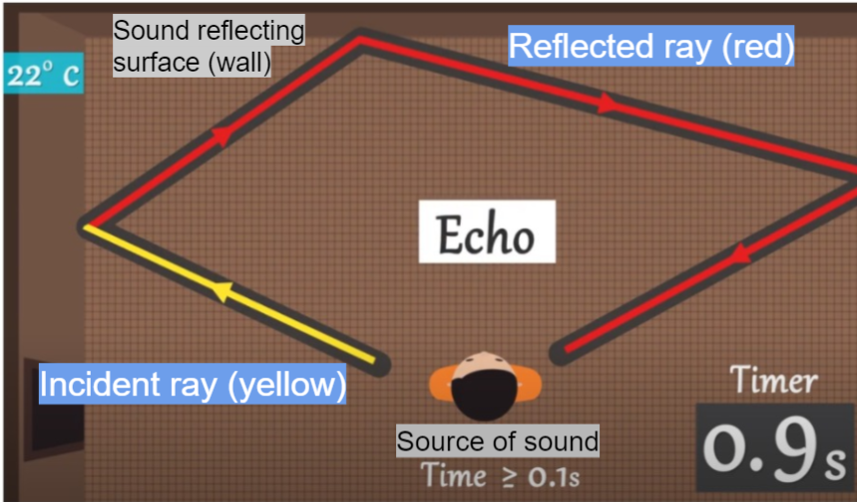
REVERBERATION
Ager hum ek band kmre me sound kare toh ye diwar se multiple times reflect hogi aur hum tak pahunchegi. Ager incident aur in multiple times reflected sound ke beech ka time interval km se km 0.1 s ho, toh hume eco sunai degi.Vastav me ek nahi bahut sari sound waves source se aa rahi hain. Ye sabhi is diwar pr alag alag angle se strike kregi aur random directions me reflect hongi. Kuchh multiple times reflect hogi jabki kuchh sirf ek ya do baar reflect hogi.
Ab yahan hamesha ek sound wave hogi jo hum tak 0.1 s se bhi km time me hum tak pahunchegi. Aise cases me hume eco nahi sunai degi lekin eco jaisi sound sunai degi kyunki yaha original sound ka koi distinct repetition nahi hai. Ye sound jo hum sun sakte hain isse reverberation kehte hain jo hume ek lambe sound ki sensation deti hai. Yaha same sound ki koi distinct repetition nahi hai. Aisa isliye hota hai kyunki do continuous sound waves jo hum tak pahunchti hai unke beech ka time difference 0.1 s se bhi km hai.
Ager yaha million sound waves hain jo hamari taraf aa rahi hain toh koi bhi do waves jo hum tak ek ke baad ek pahunch rahi hain, unke beech ka time difference 0.1 s se bhi km hoga, toh sabhi waves combine hokar hume ek lambe sound ka sensation dete hain.
Reverberation auditoriums aur bare halls me bahut common hai. Ye hall me baithe sunne walon ke life kafi kastadayak ho sakta hai. Hall ke diwaren aur roof ko sound absorbing material (s like compressed fibreboard, rough plaster or draperies) se cover kr sakte hain is problem ko solve karne ke liye. Ye jyadatar sound ko absorb krte hain aur bahut km sound reflect hoti hai.
Persistence of sound after its production is stopped, is called reverberation.
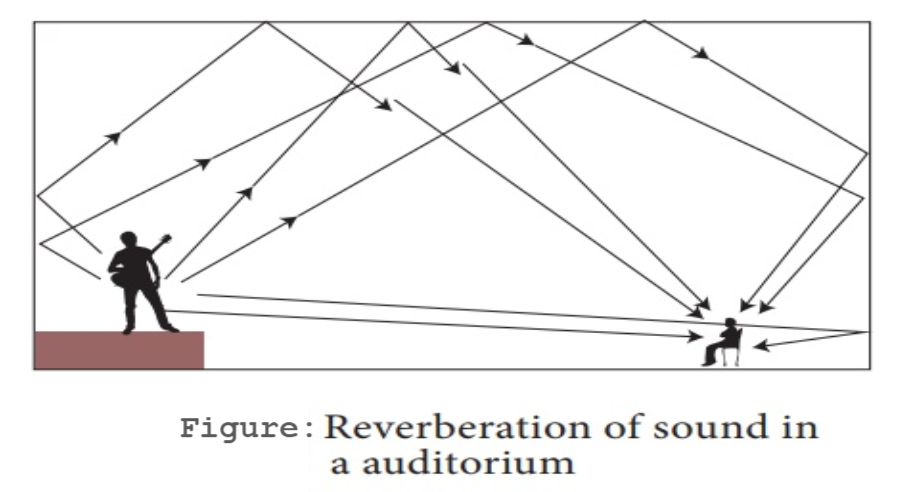
USES OF MULTIPLE REFLECTION OF SOUND
1. Megaphones ya loudhailers, horns, musical instruments jaise ki trumpets aur shehanai, ye sabhi aise design hue hain ki sound ek particular direction me send ho pae sara directions me na send ho pae.2. Stethoscope medical instruments hain jo body ke ander (mainly heart or lungs) ke sound produced ko sunne me use krte hain. Stethoscope me multiple reflection of sound ke karan patient ka heartbeat ka sound doctor ke ears tak pahuchta hai.
3. Concert halls, conference halls aur cinema halls ke ceilings curved hote hain taki reflection ke baad sound hall ke sare corners me pahunch pae. Stage ke piche kabhi kabhi sound board placed hote hain taki sound board se reflection ke baad sound hall ke chaurai me evenly spread ho pae.
RANGE OF HEARING
Kya hum hamare aas paas ke sare sound sun sakte hain? Ears sound waves aur inki vibrations ko pick karne me body ki help krta hai. Sound waves 1 sec me jitni number of vibrations produce krte hain usse frequency kehte hain. Frequency ko Hertz (Hz) me measure krte hain aur 1 Hz 1 vibration per second ke equal hota hai.Human beings 20 Hz se 20000 Hz ki frequency sun sakte hain. 5 years se km ke age ke bache aur kuch animals jaise ki dogs 25000 Hz tak ki frequency sun sakte hain. Humans ki hearing range age ke saath saath km hoti jati hai.
Elephants infrasound se communicate krte hain. Rhinoceros bhi 5 Hz jaise low frequency infrasound ko use krke communicate krte hain. Kya aap jante hai ki earthquake se phle dog kyu disturb hote hain? Earthquake main shock wave se phle low frequency ke infrasound generate krte hain.
Ultrasonic sounds bahut sare fields me use hote hain jaise ki navigation, medicine, imaging, cleaning, communication, testing etc. Bats aur porpoises prey aur obstacles ki location janne ke liye is particular technique ka use krte hain.

OMR (One Minute Revision)
- * Audible range of frequency: Our ears are sensitive only to a limited range of frequencies from 20 Hz to 20,000 Hz
* Sound of frequency above 20,000 Hz is called ultrasonic.
* Sound of frequency below 20 Hz is called infrasonic.
* Both ultrasonic and infrasonic are inaudible to human beings.
EXPLANATION
कवयित्री कहती है कि क्या इन पेड़ों को याद है कि वे कैसे तेज़ हवा में झूलते थे? कैसे वे बारिश में भीग जाते थे? और क्या उन्हें याद है कि कैसे वसंत ऋतू में उनके फूल खिल जाते थे और पतझड़ में पत्ते उनकी टहनियों से गिर जाते थे? कवयित्री कहती है कि जो दो पेड़ के टुकड़े कट कर गिर गए है वे एक दूसरे से बात करते है कि यह हवाएं जानती है कि कैसे हम उस हवा में झूलते थे और जब हवा हमसे गुजरती थी तो वहां से गीत उत्पन होता था जिसकी हम ही प्रशंसा करते थे लेकिन हमे काटने के बाद अब यह जगह सुनसान हो गयी है और अब यहाँ वह गीत उत्पन नहीं होंगे और अब इन गीतों की प्रशंसा नहीं करी जाएगी।
POINT 2
Reflection of Sound:
When sound waves strike a surface, they return back into the same medium. This phenomenon is called reflection of sound.
Echo:
Phenomenon of hearing back our own sound is called an echo. It is due to successive reflection from the surface obstacles of large size.
Reverberation:
Persistence of sound after its production is stopped, is called reverberation.
PARAGRAPH 3

Many a man is blunt,
He doesn't even sense
The agonies caught
Even in simple words
What then of these songs
They are just sounds
Such sounds as would be choked to death
If confined in the strokes and coils of script.
EXAMPLE 7
A person clapped his hands near a cliff and heard the echo after 2 s. What is the distance of the cliff from the person if the speed of the sound, v is taken as 346ms−1?
Given,
Speed of sound, v=346ms–1
Time taken for hearing the echo,
t=2s
Distance travelled by the sound
=v×t=346ms–1×2s=692m
In 2 s sound has to travel twice the distance between the cliff and the person. Hence, the distance between the cliff and the person =692m/2=346m.
IMPORTANT WORDS
Blunt- idiot, foolish, मन्दबुद्धि
Agony- great pain or suffering, पीड़ा, व्यथा, कष्ट
Choked- to kill by choking throat, गला दबाकर मारना
EXAMPLE 8
A submarine emits a sonar pulse, which returns from an underwater cliff in 1.02s. If the speed of sound in water is 1531m/s, how far away is the cliff ?
Time taken by the sonar pulse to return, t = 1.02 s
Speed of sound in salt water, v = 1531 ms - 1
Distance of the cliff from the submarine = Speed of sound × Time taken
Distance of the cliff from the submarine = 1.02 × 1531 = 1561.62 m
Distance travelled by the sonar pulse during its transmission and reception in water = 2 × Actual distance = 2d
Actual Distance, d= Distance of the cliff from the submarine/2
= 1561/2
= 780.31 m
EXPLANATION
कवयित्री बड़े ही दुख के साथ कहती है कि कुछ मनुष्य कठोर दिल के होते है। वे मन्दबुद्धि होते है जो पेड़- पौधों को काट देते है और साधारण शब्दों में कहा जाये तो जब वहां पेड़ थे और हवा उनसे गुजरती थी तो एक आवाज उत्पन होती थी मानो जैसे हवा कोई संगीत गा रही हो लेकिन अब वो गीत सुनाई नहीं देंगे और अब यह सिर्फ आवाजें बन कर रह गयी है। कवयित्री ने कहा है कि बहुत से लोगों की बुद्धि मंद और कुंद होती है। वे उस दर्द को भी नहीं पकड़ पाते जो सीधे-सादे शब्दों के माध्यम से व्यक्त की जाती है तो फिर इन गीतों को कैसे समझ पाएंगे जो केवल ध्वनियाँ है। कवयित्री ने ध्वनियों को शब्दों से ज़्यादा महत्व दिया है। अगर हवा की ध्वनियों (संगीत, आवाज) को शब्दों का महत्व दिया आएगा तो इनकी आत्मा ही मर जायेगी और उनका दम घुटकर रह जायेगा।
EXAMPLE 9
Why do we hear the sound produced by the humming bees while the sound of vibrations of pendulum is not heard ?
The frequency of vibrations of pendulum is below 20 Hz (infrasound). We cannot hear infrasound but humming produce audible sound which can be heard by human beings.
SUMMARY
EXAMPLE 10
If any explosion takes place at the bottom of a lake, what type of shock waves in water will take place ?
If any explosion takes place at the bottom of a lake. Infrasound type of shock waves in water will take place.
POETIC DEVICES
Alliteration: Alliteration is the use of the same letter or sound at the beginning of words that are close together.
For Example: 1. Branch breaking
2. sings such songs
Personification:It is the attribution of a personal nature or human characteristics to something non-human, or the representation of an abstract quality in human form. It has been used throughout the poem.
For Example:1. Such sounds as would be choked to death
2. Do they moan and groan.
EXAMPLE 11
Why is the ceiling and wall behind the stage of good conference halls or concert halls made curved ?
The ceilling of concert halls, conference halls and cinema halls are curved so that sound after reflection reaches all corners of the hall uniformly.
QUESTION ANSWERS
1. The poet has given a touching account of a tree that has been cut down. Don’t you think that this is a sad poem in memory of a felled tree?
ANSWER: Yes, I agree with this point that through cutting a tree the poet presents a sad memory of a felled tree. The tree which has been cut mercilessly must have felt a lot of pain. Branches are separated from the tree. The whispering of the logs presents its sad plight. So this poem is clearly a sad poem.
2. Why has the poet indulged in reminiscences? Has anything ever compelled you to reminisce?
ANSWER: The poet's sensitivity has been touched by the felled tree, but she continues to reflect. She has been agitated. She recognised the tree's melancholy mood in him. She's had a little too much fun with the sad tree. It is my mind that determines whether I am sad or happy. Trees do, in fact, eat, drink, and breathe. They grow in the same way as humans do. They even get some shut-eye at night. They enjoy the pleasure and suffer the furies of nature. When they are hacked they must feel pain.
Once I was going to my school hostel. I was waiting for the train. Suddenly a lady came to me and made friends with me. She called me son. She took me to the canteen and both had a good breakfast there. She talked to me a lot. When the train came I boarded the train and I looked at her. She was too looking at me and made me see off. That day always reminisces me.
3. What does ‘the wind know and what the wind blowing a din’ suggest?
ANSWER: The wind has been a long life companion of the tree. It knows how the tree suffered when it was tossed. It has been the witness to all the good and bad times of the tree. The din sound of the wind suggests that the wind shears the agony of the tree after it was hacked.
4. “Many a man is blunt, so blunt, He doesn’t even sense the agonies caught, Even in simple words.” Explain the lines.
ANSWER: The poet says that most men are dull and they don't care about the pain suffered by the poor tree. In fact, the poem conveys that it is because of their blunted sensitivity that men cut trees.
5. Justify the title of the poem.
ANSWER: Cutting of tree compel the halves to cry. The wind is also crying over the loss of the tree. But all these make sound only.The poetess wants to explain that sound is more expressive and powerful than even words. Sounds carry the words. The words would die but the sound of pain and pleasure would last forever. Hence the title of the poem ‘Sound’ subtly conveys the feeling of the poem.
6. The poem suggests that the writer of this poem is an environmentalist. She is deeply concerned with protecting and preserving the natural environment. Do you agree with it? Write your opinion.
ANSWER: The poet's way of thinking reveals that she is an environmentalist who is passionate about preserving and protecting the natural world. She does not want any trees cut down. I believe that she has made an effort to educate us about the value of trees and plant life.
7. ‘A lot of people are insensitive to the agonies of trees’. Comment.
ANSWER: Yes, it is true that a lot of people are insensitive to the agonies of trees. Instead they cut them ruthlessly. Maybe it is because they are unable to evaluate the importance of trees in human’s life. By doing this they are harming themselves.
8. What is the theme of the poem? Could you suggest another title?
ANSWER. The theme of the poem is the degradation, which nature has suffered through the hands of modern men who are blunt and insensitive to the agonies of trees. Another title may be "Echo".
9. Do trees have souls? Give your opinion.
ANSWER. The great Indian scientist Jagdish Chandra Bose has already proved that plants are living things.They eat, drink and breathe. They grow like human beings. Their green leaves produce starch. They enjoy the pleasures and suffer the furies of nature just like human beings. Hence, we can say that trees are alive and have souls.
10. Imagine yourself to be a branch that has just been hacked out. Describe your feelings to your parent tree.
ANSWER. It is a matter of regret that I have been hacked. The pain is unbearable that I have fallen on the ground lifeless. I am helpless. My agony can't be understood by blunt people who have hacked me. I was an inseparable part but these rude and blunt people have cut me apart.
APPLICATIONS OF ULTRASOUND
1. Bats apne path me obstacles ko avoid krte hain ultrasound ko produce aur sun krke. Wo jo ultrasound produce krte hain vo obstacles ko strike krke return hote hain. Reflected sound ko sun kr ke wo obstacle ka direction judge krte hain aur time travelled ko use krke wo obstacle ka distace pata kr lete hain.
2. Ultrasound ko holes drill aur materials me desired shape ka cut krne ke liye use krte hain.
3. Metals me defects ko detect krne ke liye ultrasound ka use krte hain.
4. Human organs ka imaging ke liye ultrasound ka use krte hain.
5. SONAR (abbreviated form of sound navigation and ranging) me ultrasound use krte hain underwater me objects aur unka distance pata krne ke liye.
Difference between ultrasonic and supersonic
SONAR
SONAR (abbreviated form of sound navigation and ranging) me ultrasound use krte hain underwater me objects aur unka distance pata krne ke liye.SONAR transmitter aur receiver consist krta hai jo ships me installed hote hain. Transmitter ultrasonic waves produce aur transmit krta hai. Ye waves pani me travel krte hain aur object ko strike krke reflect krte hain. Detector in reflected waves ko sense krta hai aur ultrasonic waves ko electrical waves me convert krte hain. Ultrasound ke transmission aur reception ka time interval record kiya jata hai aur object ka distance calculate krte hain. SONAR sea ke depth ko determine krne me use krte hain. Ye technique underwater hills, valleys, icebergs aur submarines, sunken ships etc locate krne me useful hai.
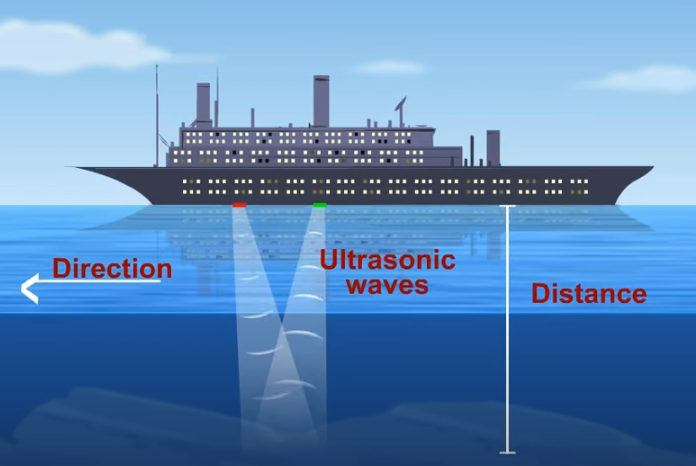
STRUCTURE OF HUMAN EAR
Human ear : Ear hamare body ka bahut sensitive part hai jiske karan hum sound sunn pate hain. Ear air ke audible frequencies ke pressure vibrations ko Electric signals me convert karte hain jo auditory nerve ke through hamare brain tak travel krte hain.Human ear ke 3 main parts hote hain.
Their auditory functions are as follows:
(i) Outer ear :
Outer ear ko pinna’ kehte hain. Ye surrounding se sound collect krta hai. Collected sound auditory canal ke through pass krta hai. Auditory canal ke end me thin membrane hota hai jisse eardrum ya tympanic membrane kehte hain. Jab object ke vibration ke karan medium ka compression produced ear drum pahunchta hai toh membrane ke bahar ka pressure increase ho jata hai aur eardrum ko inward move krta hai. Issi tarah eardrum outward move krta hai jab rarefaction pahunchta hai. Is way me eardrums vibrate krte hai.
(ii) Middle ear:
Vibrations ka volume increase krte hain middle ear ke 3 bones (hammer, anvil aur stirrup) jo lever ke jaisa act karte hain. Middle ear amplified pressure vibrations ko inner ear me transmit karte hain.
(iii) Inner ear:
Inner ear me, cochlea pressure vibrations ko electrical signals me convert krta hai. Ye Electrical signals auditory nerve ke through brain tak send hote hain, aur hume sound sunai deta hai.
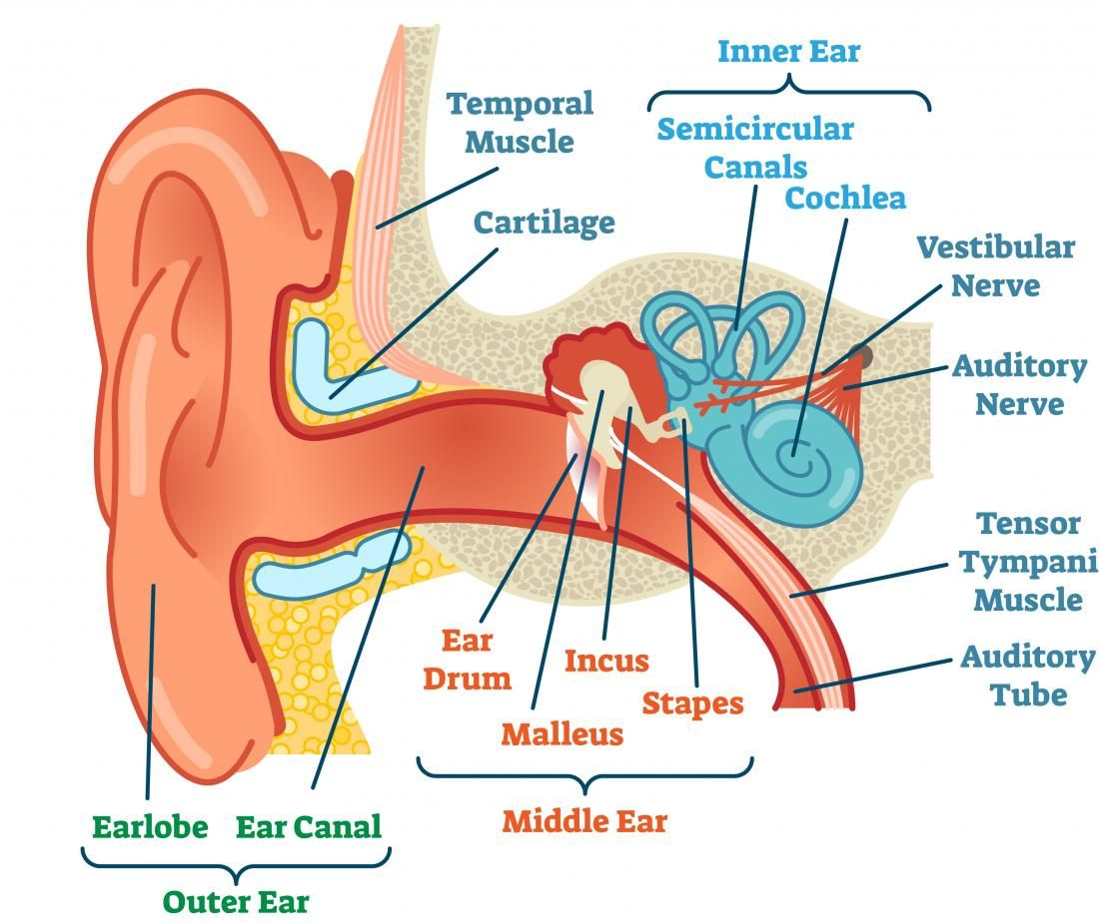
EXTRA QUESTION ANSWERS
1. How do trees help us?
ANSWER. Trees help us in many ways. They purify the air, they give us oxygen. They give shelter to wild animals and birds. They also give us fruits and fuel. They check the soil erosion and act as a balance to ecology.
2. Should you cut trees?
ANSWER. We should never cut trees.
3. Name the trees which you have in your school garden.
ANSWER. The trees in my school garden are Mango, Guava, Neem and a big Banyan tree.
4. Have you planned trees in your locality? If not, would you do it?
ANSWER. I live in a city. There is no place to plant a tree, so I have not planted any tree. Yes, I like to do it.
5. What happens to trees in the woods?
ANSWER. A tree is hacked in the woods.
6. Do the halves express their grief?
ANSWER. Yes, they express their griefs to each other.
7. Do they make a sound because they are in pain?
ANSWER. Yes, they make a sound because they are in pain.
8. Where do the logs go?
ANSWER. The logs are driven by each other and go to different places.
9. Who knows the predicament of trees?
ANSWER. The wind knows the predicament of trees.
10. Can all men sense the agonies of trees?
ANSWER. No, not all men can sense the agonies of the trees. Men who are blunt and heartless will never understand the agonies of the tree.
11. Why does the poet call the songs, not a song but just sound?
ANSWER. The poet does not call them songs but sounds because they are the cries of lamentation.
12. What will be the ultimate end of such sounds?
ANSWER. Such sounds would be choked to death as they would be confined to scripts only.
POINT 3
Sonar :
The SONAR technique is used to determine the depth of the sea and to locate underwater hills, valleys, submarines, icebergs, sunken ships etc.
PREVIOUS YEAR QUESTIONS
1. Is the title "Sound" justified?
ANSWER. The halves of the tree are forced to cry as a result of the tree being cut down. The wind is also complaining about the tree's downfall. Such loss and suffering are also regretted by the poet. All of these, however, produce only sound. The outcome is uncertain. As a result, the title 'Sound' conveys the poem's mood subtly but effectively.
2. Who cannot sense the agonies of the tree?
ANSWER. All men cannot sense and understand the agonies of the tree. Men who are blunt and foolish never draw their attention to the pain of the trees. It is important to protect and preserve our natural environment.
EXAMPLE 12
A ship sends out ultrasound that returns from the seabed and is detected after 3.42 s. If the speed of ultrasound through seawater is 1531 m/s, what is the distance of the seabed from the ship?
Given,
Time between transmission and detection, t=3.42s.
Speed of ultrasound in sea water,
v=1531m/s
Distance travelled by the ultrasound
=2×depth of the sea=2d
where d is the depth of the sea.
2d= speed of sound × time
=1531m/s×3.42s=5236m
d=5236m/2=2618m.
Thus, the distance of the seabed from the ship is 2618 m or 2.62 km.
GLOSSARY
Woods:- Forests, जंगल
Hacked- cut or chopped roughly, काट देना
Halves- plural of half, आधा का बहुवचन
Log- thick piece of wood that has fallen or been cut from a tree, लकड़ी का कुंदा जो पेड़ से गिर कर अलग हुआ है या काटा गया है
Reminisce- to talk about pleasant things that happened in the past, अतीत की सुखद बातों की चर्चा करना
Toss- to swing in the wind, हवा में झूलना या लहराना
Din- a lot of unpleasant noise that continues for some time, शोर-शराबा, हल्ला-गुल्ला
Forlorn- lonely and unhappy; not cared for, अकेला और उदास; उपेक्षित
Blunt- idiot, foolish, मन्दबुद्धि
Agony- great pain or suffering, पीड़ा, व्यथा, कष्ट
Choked- to kill by choking throat, गला दबाकर मारना
EXAMPLE 13
Sound produced by a thunderstorm is heard 10 s after the lightning is seen. Calculate the approximate distance of the thunder cloud (Given speed of sound=340ms−1).
Given, time (t)=10 s and speed (v) =340 m/s
We know that, distance =speed × time =340×10=3400 m
=34001000km=3.4km [∵1km=1000m].
EXAMPLE 14
A person has a hearing range from 20Hz to 20kHz. What are the typical wavelength of sound waves in sir corresponding to these two frequencies ? Take the speed of sound in air as 344m/s.
For a sound wave,
Speed = Wavelength ×Frequency v=λ×v
Speed of sound in air =344m/s (Given)
(i) For, v=20Hz
λ1=v/v=344/20=17.2m
(ii) For,v=20000Hz
λ2=v/v=344/20000=0.172m
Hence, for humans, the wavelength range for hearing is 0.0172 m to 17.2 m.